Introduction
I have always been interested in the shooting sports, but I have not pursued any of them while I was raising my kids. I suddenly find myself with my kids gone and my interest in shooting has reappeared. As part of my interest in shooting, I have been reading the book "Modern Practical Ballistics" by Pejsa. While reading this book, I quickly learned that not all bullet shapes are created equal. So I started to look at how bullet shapes are defined. To give you an idea of the diversity of bullet shapes, I have included Figure 1, which shows a small number of bullet shape examples.
| Source |
To make this learning exercise more concrete, I decided to focus on developing a general algorithm for computing the mass of a spitzer bullet. I made this choice after reading an interesting article that computed bullet mass using a BASIC program. I used to do a lot of BASIC programming myself, but in recent years I have found computer algebra systems to be more convenient for the working engineer to use on a daily basis. I thought the mass calculation would be a good example to use to demonstrate the power of computer algebra system to solve real problems. I will develop an algorithm for computing the mass of bullet and will test this algorithm on a real bullet design.
The overall exercise was a good exercise in applied mathematics. It also demonstrates the power of a computer algebra system. In this case, I am using Mathcad.
Descriptive Geometry of a Spitzer Bullet
The Pejsa book is focused on the spitzer (German for pointed) bullet shape, and I will concentrate on the spitzer shape as well. Today, it is the most commonly used bullet shape for hunting and target shooting applications. Figure 2 shows how this shape is defined.
As shown in Figure 2, the spitzer bullet can be modeled geometrically in three pieces:
- Ogive (pronounced "Ojive")
The ogive shape forms the front of the bullet. The ogive shape is formed from the arcs of two circles. The ogive may or may not be tangent at the point of intersection to the cylindrical portion of the bullet. When the circles are tangent to the cylinder portion, we call say this is a tangent ogive. When the circles are not tangent to the cylinder portion, we say we have a secant ogive. The rationale behind the use of the term "secant" can be seen in Figure 6, where there are two horizontal reference lines (brown color) that are both secant lines. - Cylinder
The cylindrical portion of the bullet is what engages the rifling of the barrel. - Frustum of a Cone
The back of the bullet (aka "boattail") geometrically is in the shape of the frustum of the cone Tapering the back of the bullet reduces drag, particularly at speeds less than supersonic.
I have included three examples of ogive-shaped projectiles. Figure 3 shows a bullet with a tangent ogive nose. Figure 4 shows a bullet with a secant ogive nose. Figure 5 shows one of the most famous secant ogive noses, which is on the Honest John missile. I cannot imagine the Honest John ogive being used for a bullet, but it does give a feeling for the range of shapes possible using an ogive model.
| Source | Source | Source |
Bullet Mass Calculation
Approach
We will compute the volume of the spitzer bullet as follows.
- Compute the volume of the frustum portion (VFrustum)
- Compute the volume of the cylinder portion (VCylinder)
- Compute the volume of the ogive portion (VOgive)
- Compute the total volume by summing all the volumes of the pieces
()
- Compute the mass using the density of lead (
)
Frustum Volume
The volume of the backside of a bullet (known as the boattail) has the shape of the frustum of a cone. The formula for the frustum is well known and is given in Equation 1.
| Eq. 1 |
Cylinder Volume
Equation 2 is used to calculate the volume of the cylindrical portion of the bullet.
| Eq. 2 |
Ogive Volume
Types of Ogives
The real work is in computing the volume of the ogive. Let's begin with the variables defined in Figure 6.
Using Figure 6, we can see that the different types of ogives are defined by the angle γ. There are three cases (for each case, two criteria are listed– their equivalence is shown at the bottom of this post) :
- γ < π/2
The ogive's circular arc is not tangent to the cylinder at the point of intersection. This case results in a rather pointy bullet. - γ = π/2
The ogive's circular arc is tangent to the cylinder at the point of intersection. This results in a rather curved bullet. - γ > π/2
The ogive's circular arc is not tangent to the cylinder at the point of intersection. This case results in a bulbous shape like that of the Honest John missile (see Figure 5).
Analysis
The most important cases for bullet design are when γ ≤ π/2 and the following drawings will focus on these cases. However, the equations are general and apply to all cases. We begin our ogive analysis with Figure 7, which contains the definitions of the critical angles and lengths.
We need to calculate angles α and γ. To accomplish this task, we will be working with two triangles from Figure 7 (see Figures 8 and 9).
Using Figures 7, 8, and 9, we can derive the key equations (Equations 3-6). I have used basic trigonometry and will the let the figures stand for themselves. These equations will be used in part 2 to compute the mass of two projectile examples.
| Eq. 3 |
| Eq. 4 |
| Eq. 5 |
| Eq. 6 |
Note that two equivalent criteria were listed for identifying the type of ogive. Equation 2 can be used to demonstrate this equivalence. Included below is a short derivation showing that =>
. The equivalence between the other criteria can be demonstrated similarly.
Continued on Part 2

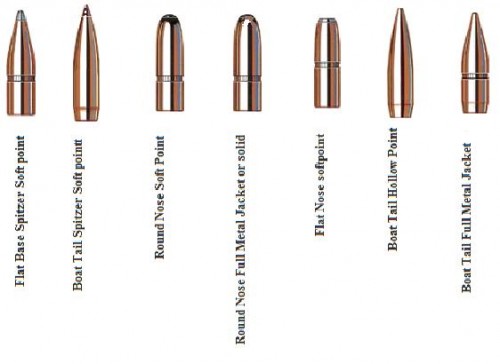



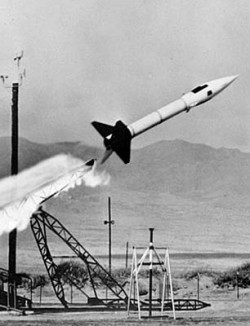
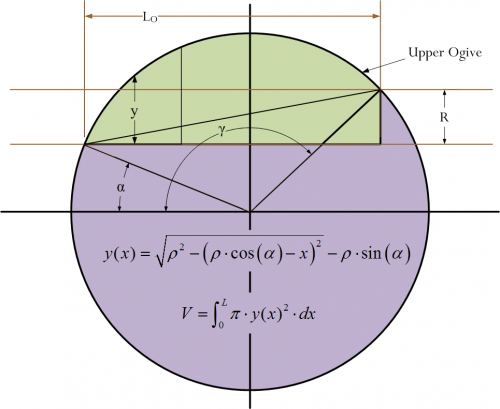

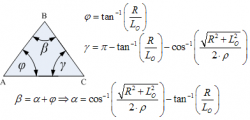
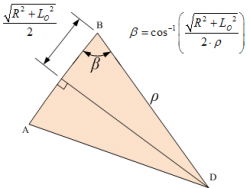
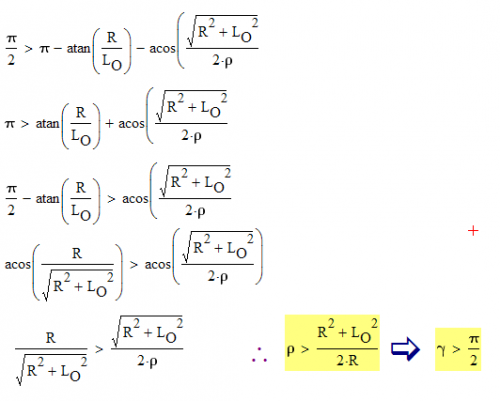
I've always wondered about bullet performance. You provide some great analysis on the Spitzer design. Looking forward to when you tackle the other examples you mentioned above. Some other users of Mathcad increased my interest because they talk about muzzle velocity, projectile motion and firemarm design.
I really enjoyed your post.
Thanks for the comments. Once I finish going through my ogive examples, I will start discussing basic ballistics. I usually blog about books I am reading. My general approach is to work through problems while reading the books so that I know I am learning the material. I want to put together material that encourages people to use computer algebra systems in their daily work.
Hello. This is fantastic material and has helped me greatly in an essay about drag coefficients of nosecone shapes. However, could you please explain the derivation of equation 3. How do you get it?
Thank you.
Now there are ventilated bullets to change the dynamics in the barrel.
http://gizmodo.com/5865769/the-compbullet-reduces-recoil-with-rocket-vents
It may be useful to read this material: http://www.if.sc.usp.br/~projetosulfos/artigos/NoseCone_EQN2.PDF. I also made some subroutines in Matlab from this material.
Thanks! I will go through it.
mathscinotes
I COULD USE SOME HELP WITH THE FOLLOWING
Spherically blunted tangent ogive
Elliptical,Haack series
AS TO BULLET NOSE SHAPES
THANKS
STEVE
Nice website. Do you have an email address? Regards, Alastair
I will send you a private note.
Mathscinotes
Though this is older, I absolutely commend and thank you for this info. Some…above my head, but most was great info. Great work man!
I'm impressed ... that I remember enough algebra to read (some of) your equations. I just wish I could read the graphs ... I've never been exposed to math graphing.
Pingback: What is the difference between a tangent ogive and a secant ogive? - Shooters Forum
Pingback: SCP HD Range Report - Page 3 - Kimber Forum
Thanks for the article. Its a very useful and intresting article, really its enhance my knowledged about bullet mass calculation.
Could some one can tell me how to calculate the volume of the bluet?. Just need some average value range.
Nice one. You always post clear and nicely researched post. Tasty one. Will try as well as recommend to friends. I got this article from google
Have you published the Mathcad worksheet on the PTC website?
No. I probably should publish most of my stuff there. I was very active on the old Mathsoft web site (Collaboratory). I became a disgruntled customer when I saw what PTC was doing to Mathcad and stopped participating. With Mathcad Prime 4.0, they appear to be working to improve the situation again. I will take a look over there.
mark
mathscinotes, what do you think about his. We've been fighting with this guy on a cast bullet forum for over a decade. Because he can't shoot cast bullets at high velocity with accuracy he made up this phoney RPM THRESHOLD theory. I've beaten his theory with many fast rifling twist rifles. You see he claims it's the fast twist that let cast bullets shoot accurately and you'll see his explanation coming up. By the way I've shot my 6.5 Swede with a 7.8 twist to jacketed bullet velocities using a cast bullet and the group size was 1/2 inch at 100 yards. The fellow who's explanation of his theory you will read can't do it. Here's his theory explained: The adverse affect of a bullet exceeding the RPM Threshold has nothing to do with bullet stability. When bullets exceed the RPM threshold and accuracy goes south we still see nice round holes in the target because the bullets are still stable in flight. Here is a brief yet concise definition of the RPM Threshold;
While the centrifugal force of RPM can and does spin some bullets apart spinning bullets apart has nothing to do with the RPM threshold. The RPM threshold occurs at a point when;
the bullet is unbalanced or becomes unbalanced due to obturation, set back , uneven swaging or canting in the bore during acceleration. The unbalanced bullet is forced to conform while in the barrel and its center of mass is revolving around its geometric center. When the bullet is free of the barrel's constraint, it will move in the direction that its mass center had at the point of release. After exiting the muzzle, the geometric center will begin to revolve about the center of mass and it will depart at an angle to the bore (line of departure). At 140,000 RPM to 250,000 RPM, depending on velocity and twist, the centrifugal force can be tremendous. How much force is exerted depends on the RPM, the location of the imbalance and the amount of the imbalance. The adverse affect results in an outward or radial acceleration from the intended flight path (line of departure) and will try to get the bullet to rotate in a constantly growing helix.
"Try to" are the key words here as there are things we do (slower burning powders, harder alloys, better designed bullets, perfect fit, etc.) that we do to push the RPM threshold upward. Conversely, using a faster powder, softer alloy, no GC, etc) lowers the RPM threshold. When the bullet goes beyond the RPM threshold it does not lose "stability”. It still is flying point forward. Its flight path simply becomes a larger expanding helical one. This is why when the RPM threshold is exceeded the group expands, as range increases, in a non linear fashion.
With cast bullets the RPM threshold will be exceeded long before the centrifugal force is enough to "spin the bullets apart". Exceeding the RPM threshold becomes apparent by the decrease in accuracy as velocity increases and the non linear expansion of group size as range increases
Are you still working on projectiles
I refer to myself as semi-retired, which means that I work on stuff that I find interesting. What do you have?
mark
I have been looking for this. There are so many guys reloading what “THEY LIKE” and ignoring the part the gun likes. The thousands of YouTube videos that talk about precision, and defining that precision as a “little bit” are an accident waiting to happen.
At this point I have not done any more than find the components, presses and data. I want to do this safely. So, my question is, with all this math and standard deviation stuff, where in precision long range shooting does probability fall in? What is the probability of putting a round in the SAME HOLE three times at 100 yards?
That is what I want to know more than anything. If your gun can not, then you can not., If your gun can, but you can’t then all you can do is get lucky.
What say you?
Thanks
Ken Hackathon brought me here. Thanks for the detailed analysis on bullet shapes and performance